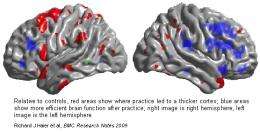Is Tetris good for the brain?

Brain imaging shows playing Tetris leads to a thicker cortex and may also increase brain efficiency, according to research published in the open access journal BMC Research Notes. A research team based in New Mexico is one of the first to investigate the effects of practice in the brain using two image techniques.
Researchers from Mind Research Network in Albuquerque used brain imaging and Tetris to investigate whether practice makes the brain efficient because it increases gray matter. For 30 minutes a day over a three-month period, 26 adolescent girls played Tetris, a computer game requiring a combination of cognitive skills. The girls completed both structural and functional MRI scans before and after the three-month practice period, as did girls in the control group who did not play Tetris. A structural MRI was used to assess cortical thickness, and a functional MRI was used to assess efficient activity.
The girls who practiced showed greater brain efficiency, consistent with earlier studies. Compared to controls, the girls that practiced also had a thicker cortex, but not in the same brain areas where efficiency occurred.
The areas of the brain that showed relatively thicker cortex were the Brodmann Area (BA) 6 in the left frontal lobe and BA 22 and BA 38 in the left temporal lobe. Scientists believe BA 6 plays a role in the planning of complex, coordinated movements. BA 22 and BA 38 are believed to be the part of the brain active in multisensory integration—or our brain’s coordination of visual, tactile, auditory, and internal physiological information. Functional MRI (fMRI) showed greater efficiency after practice mostly in the right frontal and parietal lobes including BAs 32, 6, 8, 9, 46 and BA 40. These areas are associated with critical thinking, reasoning, and language and processing.
“One of the most surprising findings of brain research in the last five years was that juggling practice increased gray matter in the motor areas of the brain,” said Dr. Rex Jung, a co-investigator on the Tetris study and a clinical neuropsychologist. “We did our Tetris study to see if mental practice increased cortical thickness, a sign of more gray matter. If it did, it could be an explanation for why previous studies have shown that mental practice increases brain efficiency. More gray matter in an area could mean that the area would not need to work as hard during Tetris play.”
“We were excited to see cortical thickness differences between the girls that practiced Tetris and those that did not,” said Dr. Richard Haier, a co-investigator in the study and lead author of a 1992 study that found practicing Tetris led to greater brain efficiency. “But, it was surprising that these changes were not where we saw more efficiency. How a thicker cortex and increased brain efficiency are related remains a mystery.”
The researchers hope to continue this work with larger, more diverse samples to investigate whether the brain changes we measured revert back when subjects stop playing Tetris. Similarly, they are interested if the skills learned in Tetris, and the associated brain changes, transfer to other cognitive areas such as working memory, processing speed, or spatial reasoning.
More information: MRI assessment of cortical thickness and functional activity changes in adolescent girls following three months of practice on a visual-spatial task; Richard J Haier, Sherif Karama, Leonard Leyba and Rex E Jung; BMC Research Notes 2009, 2:174; www.biomedcentral.com/1756-0500/2/174/abstract
Source: BioMed Central (news : web)















